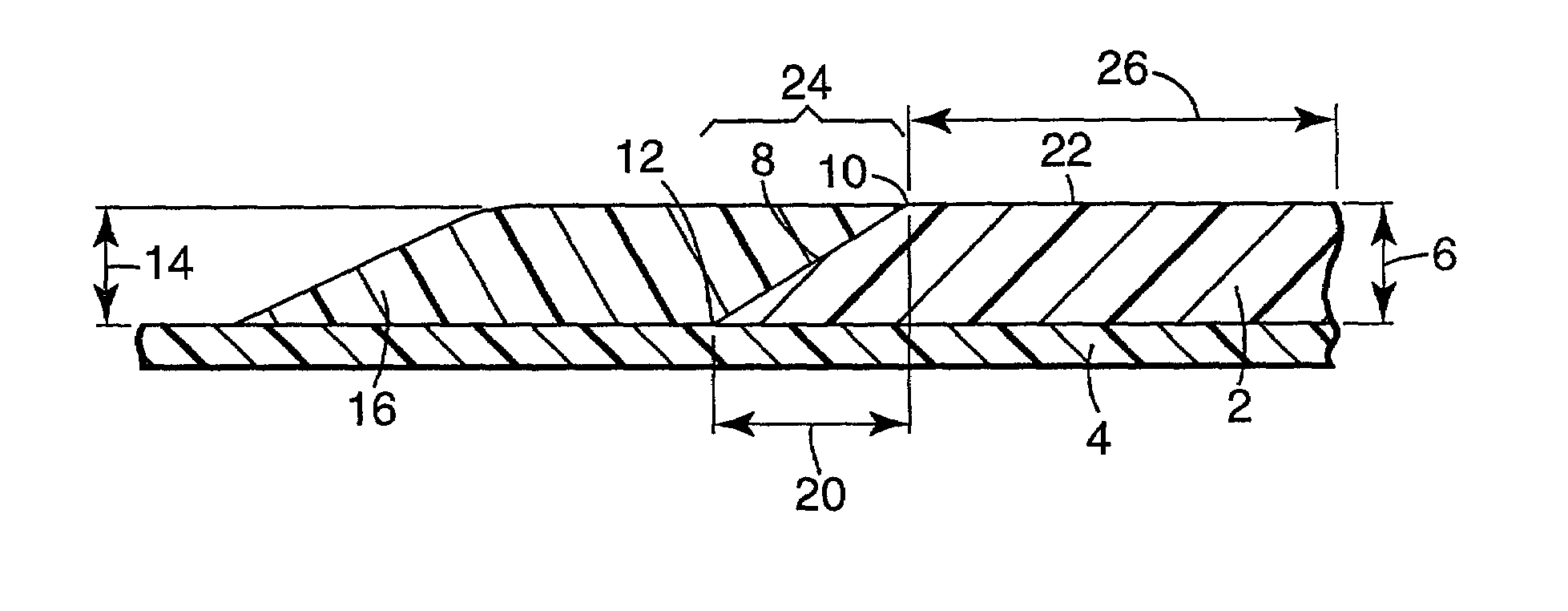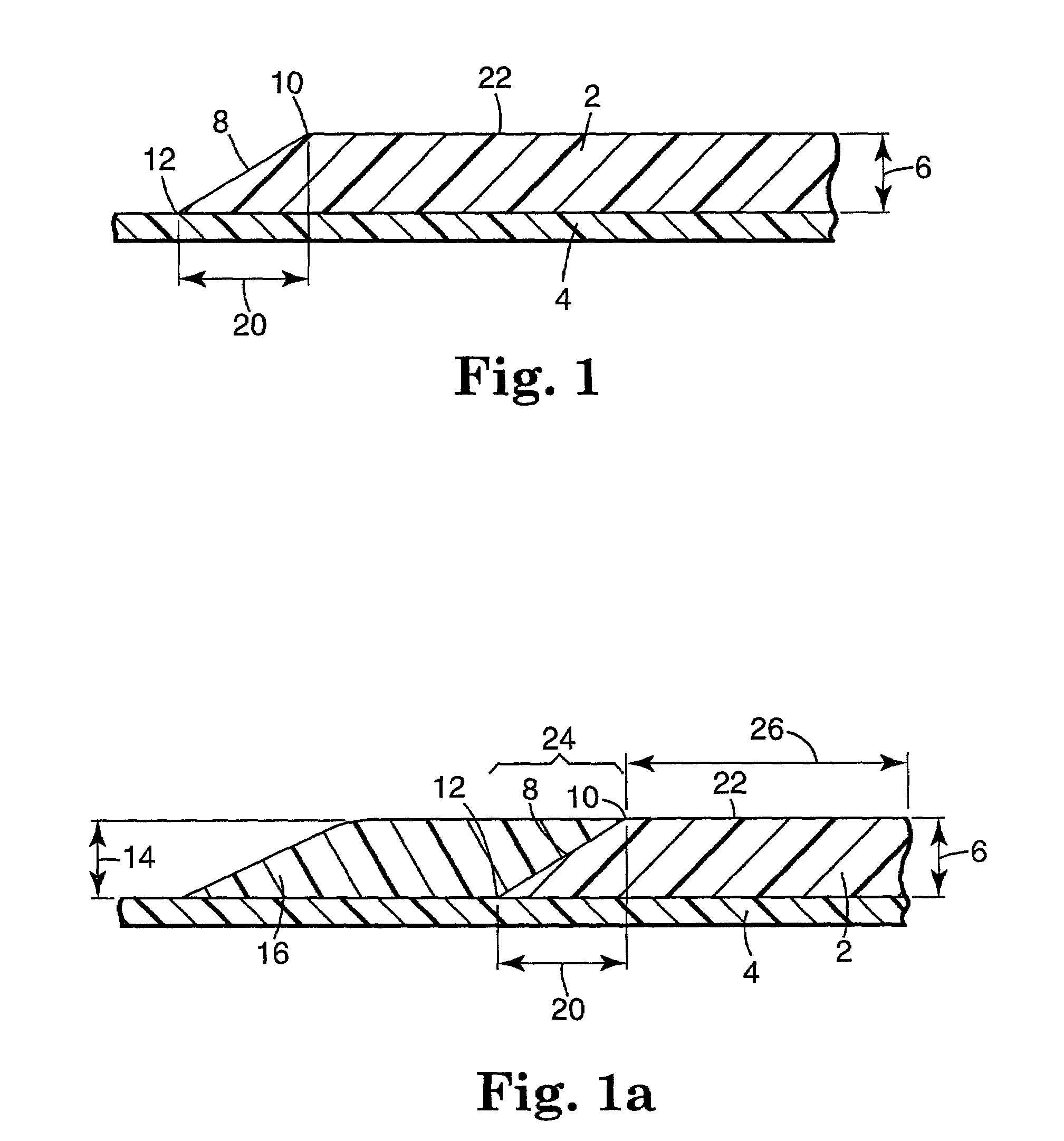Coating edge control
- Summary
- Abstract
- Description
- Claims
- Application Information
AI Technical Summary
Benefits of technology
Problems solved by technology
Method used
Image
Examples
example 1
[0110]A die (as described in WO95 / 29763 and additionally illustrated in FIG. 2b) with 2 cavities was used to coat edge barrier strips on either side of a primary coating in a continuous manner. Coatings were placed onto a 1.4 mm polyester backing.
[0111]Shims for each slot of a dual slot coater (as designated in FIG. 2b) were prepared so that openings allowed an edge of a non-active edge material to align with an edge of a cathode material (in this case active) coating to be delivered separately to the web via each of the two slots. The two coatings were coated in different orders in producing different samples, sometimes the cathode material being coated first and sometimes the edge material being coated first.
[0112]For the edge material, 21% (w / w) polyethyleoxide (Polyox WSR-N-80 MW 200.000, Union Carbide) was mixed with a solvent blend of 80% acetonitrile and 20% toluene (w / w).
[0113]For the coating (in tbis case cathode) material, the following composition, 30% w / w in 80:20 aceton...
example 2
[0117]Alternating stripes of Indicator Composition B (“indicator stripe”) at 38% solids and Barrier PSA Composition (“PSA stripe”) at 39% solids were coated onto an untreated, low-haze, 1.4-mil polyester PET transparent film backing using an extrusion die. The basic die is as described in WO95 / 29763 with two separate manifolds and slots for supplying the Composition B (Bottom Manifold) and the Barrier PSA (Top Manifold). A precision gear pump was used to supply the PSA composition to the top manifold and another precision gear pump was used to supply the indicator composition to the bottom manifold. Each pump could be adjusted independently to control flow rate of the compositions to the die. The pump flow rates were set for 2.6 mil wet for the indicator stripe, and 2.9 mil wet for the Barrier PSA Edge. An arrangement of shims allowed distribution and delivery of the Barrier PSA Edge material (1 inch width) adjacent to the Indicator Composition B material (0.5 inch width). Different...
example 3
[0119]Thin film coatings can be prepared by essentially solventless extrusion of mixtures of solid ingredients. The ingredients are intimately mixed by a variety of methods and melted and compressed through a flat orifice to produce a thin coating on a substrate.
[0120]A cathode containing an active material such as V2O5, electrically conductivity material such as carbon black, an electrolyte salt such as lithium trifluoromethanesulfate, and an ionically conductive polymer binder such as polyethylene oxide would be mixed in proportions similar to example #1 but with no solvent or liquid add. The mixture would be fed to a single screw extruder with a temperature sufficient to melt the polymer binder. The mixture would be pumped under pressure by the internal action of the extruder to a flat exit orifice. The melted mixture would be formed and cooled on a web moving past the orifice.
[0121]A second mixture would be prepared from a polymer or monomer binder. The binder may contain additi...
PUM
| Property | Measurement | Unit |
|---|---|---|
| Fraction | aaaaa | aaaaa |
| Width | aaaaa | aaaaa |
| Width | aaaaa | aaaaa |
Abstract
Description
Claims
Application Information
 Login to View More
Login to View More - R&D
- Intellectual Property
- Life Sciences
- Materials
- Tech Scout
- Unparalleled Data Quality
- Higher Quality Content
- 60% Fewer Hallucinations
Browse by: Latest US Patents, China's latest patents, Technical Efficacy Thesaurus, Application Domain, Technology Topic, Popular Technical Reports.
© 2025 PatSnap. All rights reserved.Legal|Privacy policy|Modern Slavery Act Transparency Statement|Sitemap|About US| Contact US: help@patsnap.com



